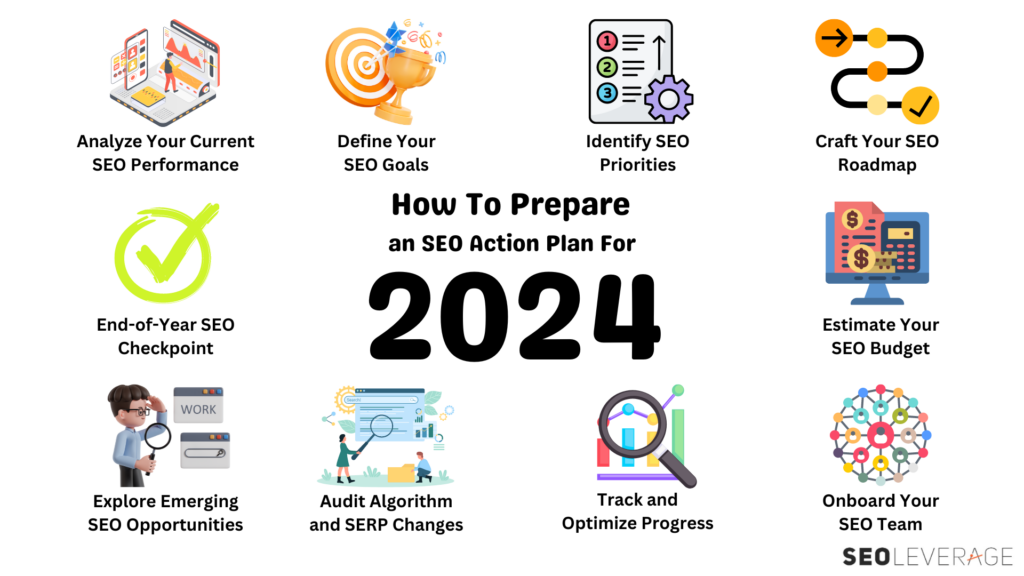Search engine optimization (SEO) is an integral part of any digital marketing strategy. With the fast-paced evolution of search algorithms and user behavior, it is essential to continuously refine your SEO efforts to remain visible in search engines and search engine results pages.
Key Takeaways:
- Conduct a comprehensive audit of current SEO health across organic traffic, technical factors, on-page optimization, rankings, link profiles, and competitors. This establishes a baseline.
- Set specific, measurable SEO goals aligned to overarching business objectives for 2024. Examples include increasing organic traffic by X% or getting backlinks from high-DR websites.
- Identify optimization priorities via expanded keyword research, technical fixes, and pillar content development around buyer journeys. Create an editorial calendar.
- Build a detailed execution roadmap outlining tasks, owners, timelines, and status tracking. Categorize by ongoing optimization, business goals, algorithm updates, and seasonal opportunities.
- Consistently track weekly progress on rankings, traffic, authority metrics, and conversion rates. Continuously optimize underperforming areas and realign plans as needed. Conduct a full audit at year-end to inform 2025 planning.
Table of Contents
Creating a yearly SEO action plan allows you to set clear SEO goals, allocate resources efficiently, and track organic search results over time. As we move into 2024, here is a step-by-step guide to preparing an effective SEO strategy for the coming year:
1. Analyze Your Current SEO Performance
Conducting a thorough keyword research audit of your current on-page and off-page SEO health is crucial for identifying areas of improvement and setting an accurate baseline before planning future efforts. Set aside adequate time for a detailed analysis across critical elements:
Organic Traffic
Track monthly users, sessions, bounce rates, pages per session, average session duration, and conversion rates from organic channels over the past 12-18 months using Google Analytics. Look for trends to identify opportunities to provide more valuable and shareable content that satisfies your target and your audience's search intent.
Segment users by source, keyword, landing page, device, and geography to uncover additional insights into the performance of target keywords and pages.
Over time, compare organic traffic metrics for your priority long-tail keywords and keyword groups.
Technical SEO
Run your site through tools like Google Search Console, PageSpeed Insights, and Screamingfrog to surface technical SEO issues impacting crawl ability, indexation, page speed, and core web vitals.
Review site architecture - ensure URLs are user-friendly, page titles and meta descriptions are unique, compelling and optimized with target keywords.
Check that the robots.txt file is correctly guiding search engine bots. Submit XML sitemaps for improved indexing.
For ecommerce sites, test internal site search functionality.
On-Page Optimization
- Pick 50+ priority pages and analyze title tags, URL slugs, header tags (H1, H2), image alt texts, keyword density, pagination, structured data markup, etc.
- Evaluate if content quality, depth, and internal link structure satisfy user search intent for focus keywords. Identify content gaps to create.
- Check translations, hreflang tags, and geo-targeted content for global multilingual sites.
Rankings & Visibility
- Verify existing ranking positions for target keywords in Google Search Console to optimize content and pages further.
- Check if you have featured snippet visibility for critical questions and ways to improve quality.
- Review search engine results page presence and optimization of business listings on directories like Google My Business.
Link Profile Analysis
- Use tools like Ahrefs and SEMRush to evaluate domain rating, total backlinks, referring domains, link growth rate, and unhealthy links.
- Analyze link velocity and build forecasts for link building.
- Check link diversity from different website DA levels and geo-locations. Identify toxic links for disavowal.
Competitive Benchmarking
Analyze competitors ranking above you for common keywords by assessing their on-page and off-page SEO strengths and strategies to identify areas for optimization.
Sign up for competitor website alerts and monitor the external marketing campaigns driving their search engine rankings growth.
This in-depth audit will give you immense clarity on where your website stands, which areas are working well, and which weaknesses need fixing as SEO inputs for 2024 planning.
2. Define Your SEO Goals
A clear vision of what you want to accomplish with SEO is key. Align SEO goals with your broader business objectives for the coming year. Goals could include:
- Increase organic traffic by __%
- Improve website authority to __ level
- Rank #1 for ___ high-value keywords
- Grow natural leads/sales by __%
- Get quality backlinks from __ high-DR websites
Make sure to establish SMART goals (specific, measurable, achievable, relevant, and time-bound).
3. Identify SEO Priorities
With a clear understanding of your current SEO standing and future targets, you can determine the priority areas for optimization in 2024. This requires a three-pronged approach:
Keyword Research
Expanding your existing keyword research to discover additional relevant search queries with good volume and low competition is imperative. These newly found keywords should then be logically grouped into topics and buyer intent stages, facilitating the definition of optimization priority. Another critical area is shifting existing focus from purely high-volume keywords to more conversion-driven ones that generate more tangible ROI.
Technical SEO Fixes
Resolving lingering indexation errors impacting pages that warrant high visibility is vital, as is enhancing website speed on mobile devices - an increasingly crucial consideration. Another technical priority is implementing structured data for better visibility in rich search snippets.
Content Development
Creating authority-building pillar web pages centered around priority keyword groups provides tangible SEO value. Similarly, bolstering existing content targeting middle and lower-funnel buyer queries can enhance lead conversion potential. Developing visual informational assets for distribution across social media and listing partners round out meaningful content development pursuits.
4. Craft Your SEO Roadmap
With your priorities identified, break down initiatives into specific SEO tasks to execute throughout the year. Maintain a roadmap calendar that outlines the following:
- Target completion timeframe for each task
- Owners responsible for each item
- Priority level - high, medium, low
- Status tracking
Categorize tasks by:
- Ongoing optimization - Technical fixes, content audits, link building
- Business goal alignment - Landing page copy, conversion tracking, etc.
- Algorithm/ SERP feature updates - Ensuring readiness for Google updates
- Seasonal opportunities - Events, holidays, tentpole moments
Set quarterly milestones for regrouping on progress made.
5. Estimate Your SEO Budget
SEO initiatives have costs associated across:
- Technology and tooling
- Content production
- External marketing activities
Based on the roadmap and resource requirements, develop an allocated budget plan to cover:
- Software/tools - Analytics, rank trackers, SEO plugins, etc.
- Creator partners - Writers, designers, developers
- Paid amplification - PPC, native ads for link-building assets
- Overheads - Strategic consulting, training, marketing hours
Continuously optimize costs by tracking ROI on initiatives and tapping best-value partners. Build upwards of 20% buffers for evaluating new opportunities during the year.
6. Onboard Your SEO Team
SEO cannot function in silos to be genuinely successful. Whether working with an in-house team or agency partner, ensure everyone involved understands:
- Business and SEO goals for the year
- Their role in achieving the core objectives
- Timelines for individual tasks
- Steps for collaboration and reporting
Conduct kick-off workshops and share docs for alignment. Streamline communication channels between content creators, technically-focused SEO specialists, link builders, and digital marketers within the team.
7. Track and Optimize Progress
Consistent tracking of SEO efforts against targets is vital for success. This involves:
- Monitoring keyword rankings and traffic metrics weekly
- Maintaining ranking tracker dashboards
- Tracking conversion performance from organic visits
Core metrics to track include:
- Organic traffic
- Keyword rankings
- Site authority factors like backlinks, domain rating
- Lead and sales conversion rates
Based on the reporting insights, optimize underperforming areas and capitalize on what works. Update task timelines and budgets accordingly.
8. Audit Algorithm and SERP Changes
Google rolls out numerous broad-core updates and more minor tweaks each year. As these changes unfold:
- Note sites losing/gaining rankings in your niche
- Check Google's public statements and expert analysis
- Align optimization to leverage updates positively
Some expected Google updates in 2024 that could impact SEO include:
- BERT-powered search updates
- Advancements in contextual search
- Additional ways to access information
- More integrations between search and Google’s tools
Stay proactive in adapting to Google’s innovations.
9. Explore Emerging SEO Opportunities
As consumer search behavior evolves, new optimization avenues manifest, which savvy SEOs can capitalize on before others. In 2024, some trends to experiment with include:
- Optimizing for voice search queries
- Incorporating AR/VR to engage visitors
- Structured data for featured snippets
- Video SEO and YouTube optimization
- Leveraging SEO with AI
The early bird gets the worm! Pilot emerging areas, even if at a smaller scale.
10. End-of-Year SEO Checkpoint
As you end 2024 and prep for the next year, conduct a holistic audit by revisiting steps #1 to #3 above.
- Evaluate organic growth attainment
- Review keywords ranking progress
- Identify areas of strong and weak performance
This will provide data-backed input for 2025 planning to support continuous improvement. It will also help demonstrate the ROI delivered by SEO.
Creating a robust SEO plan requires effort but delivers exponential dividends. With these steps, you are heading to SEO success in 2024!
However, this still takes time, resources, and expertise, which you may need more. Setting your SEO strategy and its execution into the hands of experts may be wise.

SEOLeverage Can Help
With over 15 years of experience executing result-driven SEO campaigns internationally across diverse industries, SEOLeverage has the knowledge and skills to audit your website's health, accurately identify your most impactful optimization opportunities, and craft an air-tight SEO strategy tailored to your business goals in 2024.
We stay updated with the latest SEO trends and search algorithm innovations to deploy proven tactics that boost your organic search visibility, keyword rankings, and revenue. Ready to grow your SEO in 2024? Call us.

